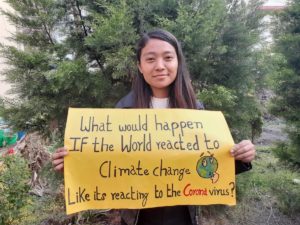“I decided to take the role of a climate warrior”
Children’s lives and futures are under threat from the climate crisis. They have contributed the least to the climate crisis but will be the most affected by its impacts. Every child will now inherit a planet with more severe and with more frequent extreme weather events than ever before because of a failure of past generations to protect their rights and their future.
Children and young people are leading the way on climate action. Whether through online campaigning, protesting on the streets, changing their habits, reducing waste, or using reusable bags, children and youth have begun to fight back against the climate crisis.
Children and youth are demanding more from world leaders and it’s time we listened. The world must recognise and stand with children, their voices, activism and leadership in the climate movement. As world leaders meet at the Biden administrations Earth Day climate summit, governments, donors and international institutions must:
- Put children, their voices and their rights at the centre of climate discussions, commitments and policies.
- Provide real and meaningful opportunities for children to engage in international and national climate discussions and policy development.
- Urgently increase finance to support vulnerable communities so they can adapt to the climate crisis.
- Invest in safety nets for children and families impacted by the climate crisis.
We spoke to 22-year-old Shreya, a youth climate activist from Nepal who participated in Save the Children’s Red Alert on Climate campaign. Shreya shares how the climate crisis has affected her life and her country and the climate action she wants to see from world leaders.

Namaste. My name is Shreya K.C. I am passionate about learning new things and doing social work. Five years back, I was unaware of the climate crisis and its dangerous environmental impacts. Until it was on the 1st day of my class in Environmental Science that I learned about the effects of the horrifying impact of the climate crisis. I had read about global warming and acid rain in my school but didn’t know its urgency.
I researched about it more and found severe problems such as climate-induced migration and extreme weather events. I was terrified. At first, I was hopeless. Slowly and gradually, I concluded, “we all are affected and will continue to suffer more”. So, rather than being a victim of climate change, I decided to take the role of a climate warrior.
I have been actively involved in raising awareness, influencing policymakers, and taking climate action. In 2017, I participated in the National Youth Conference on Climate Change organized by the Nepalese Youth for Climate Action (NYCA). The conference motivated me to join the network and make a collective impact. Since then, I have been working with NYCA, a youth-led coalition of the Nepalese youth and youth groups tackling the climate crisis, which is the biggest challenge of our generation.
We believe that addressing the climate crisis is an opportunity to create a more sustainable, just, and fair planet for all of us. At every level, NYCA is led by young people for the future of young people.
Nepal is among the most vulnerable countries to the climate crisis. In just two years, a Nepali peak, Mount Saipal, has become snowless. Our lives are melting along with our mountains. As the impact of climate change intensifies over time, it is the young people of today who will face the worst effects. I am one among them. Children are hardest hit by human-induced climate change as it limits their access to essential services such as foods, shelters, and education. It threatens their rights too.
Young people are unable to go to school due to the disaster. Many of them are losing life at an early age from different stressors combined due to climate change. Youth are experiencing and will experience more difficulty in finding decent jobs, opportunities and freedom.
My message to the government is, “We are watching you. Your every action makes a difference for millions of people. The choice to decide whether to make a positive impact or bring out the worst consequences from it is on you. Please do remember that when you are using your power and making decisions”.
Governments must pledge to be climate neutral by 2030, divest fully from fossil fuels by 2025, invest in the green economy and sustainable solutions, prepare ambitious climate action plans, provide climate finance to the poor and vulnerable states, address the rights of women, vulnerable communities and indigenous people, involve children and youth in the decision-making process, foster mandatory climate education, and ‘don’t just preach, turn the words into actions.
To ‘today’s children and youth, I would like to say that we are already doing an excellent job by igniting a new and fierce global momentum against the climate crisis. However, we have to do more! We cannot fight the climate crisis with only a small number of people. As it affects everyone, we need everyone to join us. Make yourself aware of the crises at first. Read and research about climate change, and share your knowledge with your peers. Include the conversations about the climate at your dining table with your family, friends, etc. We need to normalize people talking about the climate crisis, especially in a country like ours. Be a part of an environmental network, inspire others by modelling good behaviour, and most importantly, hold your leaders accountable.
This generation is the last generation to tackles the climate crisis and turn the trajectory to a better position. The role of children and youth in campaigning for climate justice is very crucial. It is us who will be most affected by the ‘adults’ decisions and actions of today.
Save the Children is supporting and empowering children to raise their voices on the climate crisis. Shreya was interviewed as a part of Save the Children’s Asia region Red Alert on Climate campaign.


